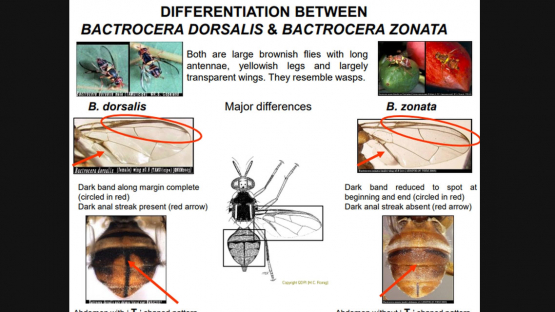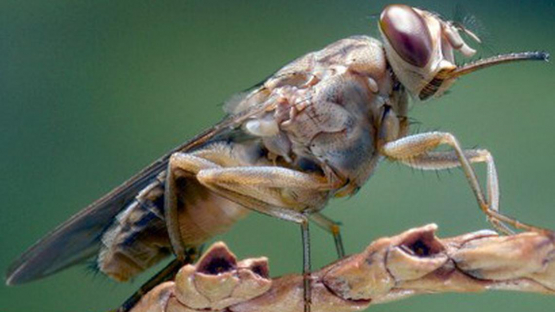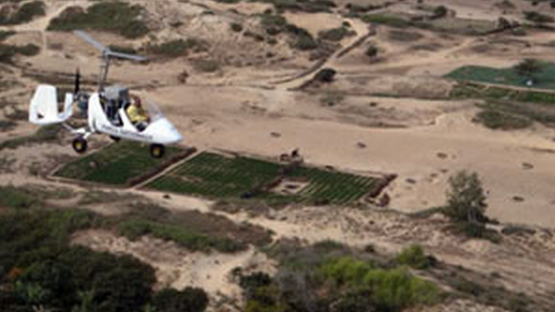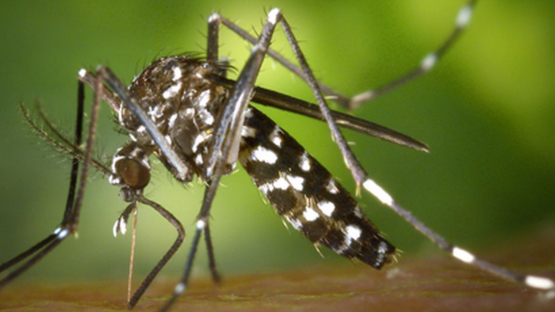IPC highlights

Tiny Pest, Big Problem: South Africa's Citrus Challenge
The false coddling moth has been plaguing South Africa's citrus crops, putting this lucrative industry in danger. Now farmers are working with top scientists to sterilize these pests and keep this industry growing. (Video Source: CNN)

Machine Learning Can Control Tsetse Flies
FEMALE tsetse flies mate for life. Or, to put it more accurately, they mate once in a lifetime. That gives those who would control these pests an opportunity. A female that mates with a sterile male will have no offspring.

Update of the Technical Leaflet Released in Six Languages on the Discrimination Between Two Invasive Bactrocera Fruit Fly Pests
Bactrocera zonata (peach fruit fly) sometimes overlaps in terms of distribution with Bactrocera dorsalis (Oriental fruit fly). A technical leaflet to help to discriminate among these two invasive pest species, was updated and produced. This document is also available in: Arabic, Chinese, French,Portuguese and Spanish.

Nuclear Technique Helps Prevent Insects from Harming Your Coffee Beans
Recent studies have shown that the Mediterranean fruit fly inflicts economic damage to coffee production by reducing weight of the coffee bean and affecting quality. The sterile insect technique integrated with other control methods is being used to control the pest protecting coffee production and industry. This video is also available in Spanish.

Third FAO/IAEA International Conference on Area-Wide Management of Insect Pests: Integrating the Sterile Insect and Related Nuclear and Other Techniques
The Conference was held from 22 - 26 May 2017 at the Vienna International Centre, Vienna, Austria. The successful conference was attended by 360 delegates from 81 countries, six international organization, and nine exhibitors.

Teamwork Award from FAO-AG Department to IPPC-IAEA Joint Team on the Fruit Fly Standards
On 26 January 2017 an award for exceptional teamwork was conferred on the cross-UN agency team consisting of staff from the Joint FAO/International Atomic Energy Agency (IAEA) Division of Nuclear Techniques in Food and Agriculture, and staff from the Standard setting unit of the IPPC Secretariat.

Success Stories on the Use of the Sterile Insect Technique (SIT) and Other Related Nuclear Techniques
The stories present a brief summary of the successful application of SIT for prevention, containment and eradication as well as other applications of nuclear energy such as for enhancing biological control.

Edward Knipling and Raymond Bushland Win Award for the Sterile Insect Technique
Two prominent members of the Entomological Society of America were posthumously selected as winners of the Golden Goose Award, which honors scientists whose federally funded work may have been considered silly, odd, or obscure when first conducted but has resulted in significant benefits to society.

Interview with Jorge Hendrichs, Head of the Insect Pest Control Section
It is feasible to eradicate the Mediterranean fruit fly from the Dominican Republic. Available only in Spanish.

Eight Year Study on Tsetse Fly Populations in West Africa Aimed at Optimising Eradication Programmes
The FAO and IAEA have been supporting an 8 year study on the tsetse fly Glossina palpalis gambiensis in West Africa that aimed at developing methodologies to optimise eradication programmes.

Zanzibar Remains Free of Tsetse, 18 Years After Eradication Was Declared
Up until the late 1990s, the island of Unguja, Zanzibar (United Republic of Tanzania) was infested with tsetse - Glossina austeni Newstead. Trypanosomosis prevalence among the mostly indigenous cattle averaged around 19 percent and the rural farming communities were unable to maintain livestock as a basis for productive mixed farming.

IAEA Recognized for Its Contribution to Tsetse and Trypanosomiasis Eradication in Africa
The IAEA has been presented with a certificate recognizing technical support that is provided by the Joint FAO/IAEA Centre of Nuclear Techniques in Food and Agriculture to member countries of the Pan African Tsetse and Trypanosomiasis Eradication Campaign (PATTEC).

Controlling Fruit Fly Pest by Releasing Sterile Male Insects
Fruit flies attack many important fruit crops, including citrus, mango, apples, peaches, apricots as well as some vegetables (especially cucurbits), seed crops and many wild plants.

World Malaria Day: How a Nuclear Technique Could Provide a Future Method for Mosquito Control
Malaria represents an important public health issue in Sudan—among hospitals and health clinics in the country’s northernmost regions, malaria is among the most commonly diagnosed and treated diseases.

Best Sustainable Development Practices on Food Security - Expo Milano 2015
The FAO/IAEA project "Eradication of the tsetse fly Glossina palpalis gambiensis from the Niayes in Senegal" was among 18 selected for "Best Sustainable Development Practices on Food Security" by an International Selection Committee from among 749 proposals admitted to the final evaluation process for Expo Milano 2015.

Okanagan - Kootenay Sterile Insect Release Program Up for International Award
The Okanagan-Kootenay Sterile Insect Release program has been nominated for a prestigious integrated pest management (IPM) achievement award, to be handed out this spring at the eighth annual International IPM Symposium, to be held held in Salt Lake City, Utah, March 23 to 26.

Four in One – New Discovery on Pest Fruit Flies
Four of the world's most destructive agricultural pests are actually one and the same fruit fly, according to the results of a global research effort released today. The discovery should lead to the easing of certain international trade restrictions and also aid efforts to combat the ability of these harmful insects to reproduce, experts said.

X-Rays Can Be Used to Sterilize Mosquitoes
Since the 1950s, scientists have used radiation to sterilize insects, which are then released into the wild to mate, but no offspring are produced. Known as the sterile insect technique (SIT), this insect-control method has traditionally relied on gamma rays to sterilize the insects.

The FAO/IAEA Tutorial DVD on Using Open Source GIS Techniques in Insect Pest Control Programmes
Area-wide insect pest control programmes rely on updated geospatial data for efficiently conducting and evaluating baseline data surveys and progress monitoring. Soft- and hardware available as geographic information system (GIS) packages are applied to analyse and understand these data for planning and implementing optimized pest intervention strategies.
- ‹ previous
- 2 of 2

